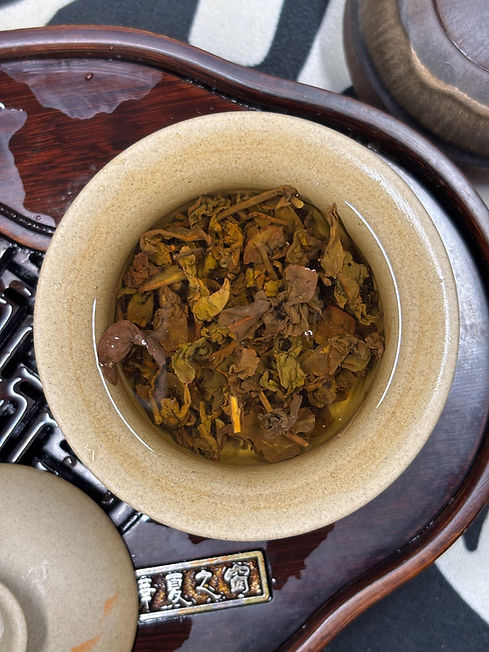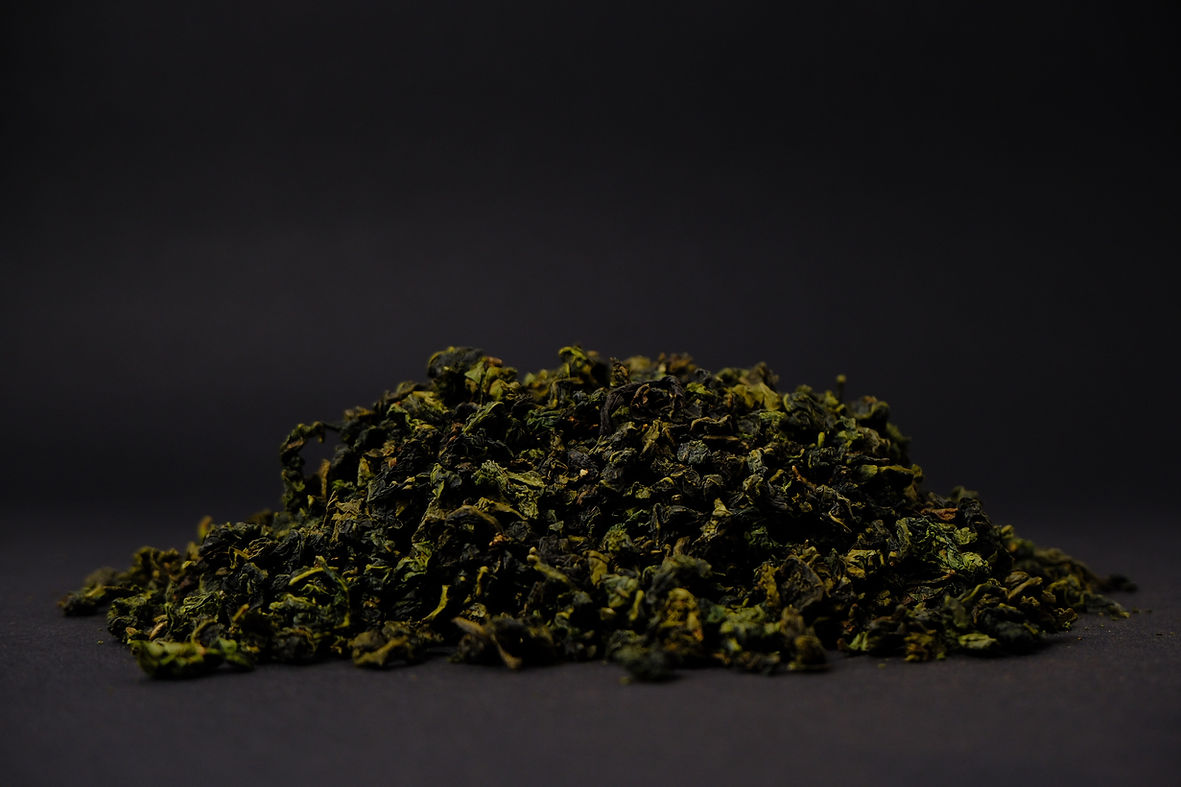Brewing Guide & Tea Guide
Chinese tea brewing guide — oolong, pu-erh, green, white, red, GABA. Learn ideal temperatures, steeping times, and ratios to unlock full flavor and aroma.


What is Shu Puerh?
Shu Pu-erh, also known as “ripe Pu-erh,” is a tea from Yunnan that undergoes an accelerated fermentation process developed in the 1970s. It has a deep, earthy flavor with notes of wood, dried fruits, and gentle sweetness. This tea is valued for its velvety texture and calming energy, which aids digestion and warms the body. For beginners, Shu Pu-erh is an accessible and comforting way to explore aged teas.
How to brew Shu Puerh?
Shu Pu-erh
-
Dosage (teapot): 5–6 g per 100 ml
-
Water temperature: 90–95 °C
-
Brewing steps:
-
Warm the teapot.
-
Rinse the tea leaves.
-
First 3 infusions: 10–15 seconds each.
-
For subsequent infusions, add +15 seconds each time.
-
-
Thermos brewing: 1 L / 5 g
-
Origin: Menghai, Xishuangbanna, Yunnan, Baiyinshan, Mansong, Lincang
What is Sheng Puerh ?
Sheng Pu-erh is the raw, naturally aged tea from Yunnan. It’s alive — changing in taste and character as the years pass.
Young Sheng:
-
Fresh, floral, fruity, sometimes sharp.
-
Strong uplifting energy, similar to a bold green tea.
Aged Sheng:
-
Smooth, woody, honeyed, with dried-fruit notes.
-
Calming, grounding, highly prized by collectors.
Why it’s loved:
-
Evolves beautifully with time, each year adding depth.
-
Rich in antioxidants, supports focus, digestion, and balance.
How to brew Sheng Puerh ?
-
Dosage (teapot): 3 g per 100 ml
-
Water temperature: 75–85 °C (depends on age — the younger the tea, the lower the temperature)
-
Brewing steps:
-
Warm the teaware.
-
All infusions should be quick, 10–15 seconds each.
-
Between infusions, open the lid to prevent steaming the leaves for too long.
-
-
Thermos brewing: 1 L / 5 g
-
Origin: Bulangshan, Mansong, Jingmai, Nannuoshan



What is Tie Guan Yin & Light Oolongs?
-
Tie Guan Yin:
A famous oolong from Fujian. Floral, orchid-like aroma, silky and sweet aftertaste. Elegant, refreshing, and perfect for multiple brews. Supports focus and relaxation. -
Light Oolongs:
Partially oxidized teas, bright and fragrant. Fresh, floral, sometimes fruity, with gentle sweetness. Easy to enjoy, boost metabolism, give clean, balanced energy.
How to brew Tie Guan Yin
(same for all light oolongs)?
-
Dosage (teapot/gaiwan): 3 g per 100 ml
-
Water temperature: 80–90 °C (lower temperature gives a creamier, more relaxing taste)
-
Brewing steps:
-
Warm the teaware.
-
Rinse the tea leaves.
-
Let the leaves rest for 60 seconds to “breathe” and open up.
-
Infusions: 15–30 seconds.
-
-
Thermos brewing: 1 L / 5 g
-
Origin: Anxi

What is
GABA Tea?
-
What it is: tea processed without oxygen, rich in natural GABA that calms and balances.
-
Flavor: smooth, sweet, with fruity or nutty notes.
Types: -
GABA Oolong – light, floral, soothing.
-
GABA Black – deeper, sweet, caramel-like.
-
GABA Green – fresh, grassy, rare.
-
Loved for stress relief, clear mind, and gentle energy.
How to brew
GABA Tea (all types)
-
Dosage (teapot/gaiwan): 3 g per 100 ml
-
Water temperature: 80–90 °C (higher temperature = less relaxing effect)
-
Brewing steps:
-
Do not rinse — GABA content is highest in the first 3–4 infusions.
-
Infusions: 20–40 seconds.
-
Thermos brewing: 1 L / 5 g
-
Origin: Taiwan — Nantou, Alishan, Volcanic regions



What is White Tea?
What it is: the least processed tea — just dried young buds and leaves, keeping their natural purity.
Flavor: delicate, light, with notes of honey, flowers, and fresh grass.
Types:
-
Silver Needle – only buds, very soft and sweet.
-
White Peony – buds + leaves, fuller and richer.
-
Shou Mei – stronger, deeper, with fruity notes.
Loved for its gentle taste, antioxidants, and calming, refreshing energy.
How to brew
White Tea (all types)
-
Dosage (gaiwan): 4 g per 100 ml
-
Water temperature: 70–90 °C (higher temperature = more energizing effect)
-
Brewing steps:
-
Rinse the leaves.
-
Let the tea rest for 60 seconds to “breathe.”
-
Infusions: 15–30 seconds.
-
Thermos brewing: 1 L / 5 g
-
Origin: Fujian, Yunnan, Guangxi

What is Dark Oolongs ?
(Da Hong Pao, Dan Cong, Shui Xian...)
-
What it is: oolongs with higher oxidation and roasting, giving them depth and strength.
-
Flavor: rich, roasted, with notes of caramel, nuts, wood, and sometimes minerals.
-
Types:
-
Da Hong Pao – famous Wuyi rock tea, bold and mineral.
-
Oriental Beauty – sweet, fruity, honey-like.
-
Other roasted oolongs – warm, toasty, comforting.
How to brew
Dark Oolongs (Da Hong Pao, Dan Cong, Shui Xian)
-
Dosage (gaiwan): 3 g per 100 ml
-
Water temperature: 80–90 °C
-
Brewing steps:
-
Rinse the leaves.
-
Let the tea “breathe” before brewing.
-
Infusions: 10–20 seconds.
-
Thermos brewing: 1 L / 5 g
-
Origin: Wuyi Shan, Guangdong



How to brew
Green Tea
What it is: the most traditional tea of China, minimally oxidized to keep freshness and vitality.
Flavor: light, grassy, floral or nutty — always clean and refreshing.
Types:
-
Long Jing (Dragon Well) – nutty, smooth, very famous.
-
Bi Luo Chun – floral, fruity, elegant.
-
Mao Feng – delicate, sweet, refreshing.
Loved for its antioxidants, clarity of mind, and pure, uplifting energy.
How to brew
Green Tea
-
Dosage (gaiwan): 2 g per 100 ml
-
Water temperature: 80 °C
-
Brewing steps:
-
Rinse the leaves.
-
Let the tea “breathe” before brewing.
-
Infusions: 10–40 seconds.
-
-
Thermos brewing: 1 L / 4 g
-
Origin: West Lake (Xihu), Jiangsu (Taihu Lake), Anhui

What is Chinese Red Tea?
-
What it is: fully oxidized tea (called “red” in China, “black” in the West), known for depth and warmth.
-
Flavor: rich, sweet, malty, with notes of honey, caramel, or dried fruit.
-
Types:
-
Dian Hong – smooth, sweet, with golden buds.
-
Keemun – floral, wine-like, slightly smoky.
-
Lapsang Souchong – bold, smoky, unique.
-
Loved for its comforting taste, steady energy, and warming character.
How to brew
Red Tea (all types)
-
Dosage (teapot/gaiwan): 3 g per 100 ml
-
Water temperature: 80–90 °C (higher temperature = less relaxing effect)
-
Brewing steps:
-
Do not rinse — GABA content is highest in the first 3–4 infusions.
-
Infusions: 20–40 seconds.
-
Thermos brewing: 1 L / 5 g
-
Origin: Taiwan — Nantou, Alishan, Volcanic regions





_JPG.jpg)




